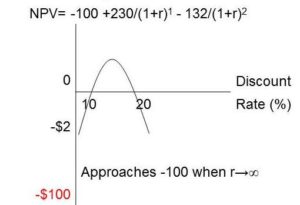Multiple Internal Return of Return (IRR) for Mixture Project
Internal rate of return (IRR) is the discount rate that makes Net Present Value (NPV) of investment zero.
NPV = initial cash flow – sum of present value of each cash outflow + sum of present value of each cash inflow
Mixture project has multiple IRRs. In theory, a cash flow stream with K changes in sign after initial cash flow can have up to positive K sensible interest rates of return.
Project Decision:
It is invalid IRRs for mixture project decision, but to avoid the multiple-IRR problem, we can solve this case with following methods:
- Use Modified IRR (MIRR): combining cash flows until only one change in sign remains.
- Build Net Present Value (NPV) graph/profile
Example:
Company has the following Project A for investment opportunity.
| Project A | |||
| Dates: | 0 | 1 | 2 |
| Cash Flow | -$100 | $230 | -$132 |
NPV= -100 + 230/(1+r)^1 – 132/(1+r)^2
IRR1= 10%
IRR 2 =20%
Required:
- Assume that required rate of return is 14%, using Modified Internal Rate of Return (MIRR) for project decision.
- Build graph or profile, and commend this project.
Solution:
- MIRR
- For project A, Cash outflow at date 2 is -$132.
- With a discount rate of 14 percent, so PV=-$132/(1+14%)= -$115.79
- The adjusted cash flow at date 1 is $114.21(130-115.79). Thus, the MIRR approach produces the following two cash flows for the project: (-$100, $114.21)
- Adjusted NPV=-100+114.21/(1+IRR)=> IRR=14.21%
- Because of IRR=14.21%> 14%, so the project should be accepted if required rate of 14%.
- Graph or Profile
- Project A has two changes of sign in its cash flows. It has an outflow at date 0 ,an inflow at date 1, and an outflow at date 2.
- This project has given two IRRs: 10% and 20%, and its NPV is positively when discount rate between 10% and 20%.
- According to graph, if required rates are between 10% and 20% (rates make positive NPVs), so the Project A will be accepted otherwise rejected.
Source:
- Phnom Penh HR
- Mcgraw-Hill – Fundamentals Of Corporate Finance

